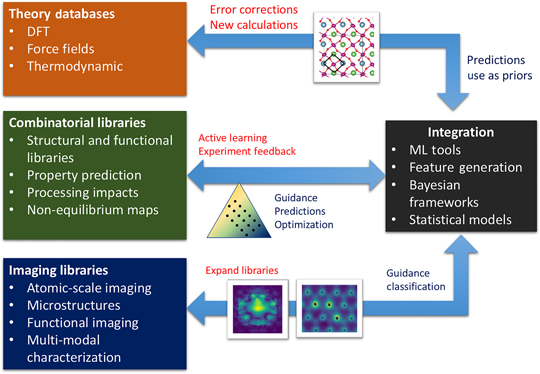Crossref Citations
This article has been cited by the following publications. This list is generated based on data provided by
Crossref.
Pinomaa, Tatu
Yashchuk, Ivan
Lindroos, Matti
Andersson, Tom
Provatas, Nikolas
and
Laukkanen, Anssi
2019.
Process-Structure-Properties-Performance Modeling for Selective Laser Melting.
Metals,
Vol. 9,
Issue. 11,
p.
1138.
Louis, Steph-Yves
Zhao, Yong
Nasiri, Alireza
Wang, Xiran
Song, Yuqi
Liu, Fei
and
Hu, Jianjun
2020.
Graph convolutional neural networks with global attention for improved materials property prediction.
Physical Chemistry Chemical Physics,
Vol. 22,
Issue. 32,
p.
18141.
Zhong, Qigang
Li, Xuechao
Zhang, Haiming
and
Chi, Lifeng
2020.
Noncontact atomic force microscopy: Bond imaging and beyond.
Surface Science Reports,
Vol. 75,
Issue. 4,
p.
100509.
Gordon, Oliver M
and
Moriarty, Philip J
2020.
Machine learning at the (sub)atomic scale: next generation scanning probe microscopy.
Machine Learning: Science and Technology,
Vol. 1,
Issue. 2,
p.
023001.
Batra, Rohit
Dai, Hanjun
Huan, Tran Doan
Chen, Lihua
Kim, Chiho
Gutekunst, Will R.
Song, Le
and
Ramprasad, Rampi
2020.
Polymers for Extreme Conditions Designed Using Syntax-Directed Variational Autoencoders.
Chemistry of Materials,
Vol. 32,
Issue. 24,
p.
10489.
Choudhary, Kamal
Garrity, Kevin F.
Reid, Andrew C. E.
DeCost, Brian
Biacchi, Adam J.
Hight Walker, Angela R.
Trautt, Zachary
Hattrick-Simpers, Jason
Kusne, A. Gilad
Centrone, Andrea
Davydov, Albert
Jiang, Jie
Pachter, Ruth
Cheon, Gowoon
Reed, Evan
Agrawal, Ankit
Qian, Xiaofeng
Sharma, Vinit
Zhuang, Houlong
Kalinin, Sergei V.
Sumpter, Bobby G.
Pilania, Ghanshyam
Acar, Pinar
Mandal, Subhasish
Haule, Kristjan
Vanderbilt, David
Rabe, Karin
and
Tavazza, Francesca
2020.
The joint automated repository for various integrated simulations (JARVIS) for data-driven materials design.
npj Computational Materials,
Vol. 6,
Issue. 1,
Choudhary, Kamal
Garrity, Kevin F.
Sharma, Vinit
Biacchi, Adam J.
Hight Walker, Angela R.
and
Tavazza, Francesca
2020.
High-throughput density functional perturbation theory and machine learning predictions of infrared, piezoelectric, and dielectric responses.
npj Computational Materials,
Vol. 6,
Issue. 1,
Ge, M.
Su, F.
Zhao, Z.
and
Su, D.
2020.
Deep learning analysis on microscopic imaging in materials science.
Materials Today Nano,
Vol. 11,
Issue. ,
p.
100087.
Peerless, James S.
Sevgen, Emre
Edkins, Stephen D.
Koeller, Jason
Kim, Edward
Kim, Yoolhee
Gargt, Astha
Antono, Erin
and
Ling, Julia
2020.
Design space visualization for guiding investments in biodegradable and sustainably sourced materials.
MRS Communications,
Vol. 10,
Issue. 1,
p.
18.
Rohr, Brian
Stein, Helge S.
Guevarra, Dan
Wang, Yu
Haber, Joel A.
Aykol, Muratahan
Suram, Santosh K.
and
Gregoire, John M.
2020.
Benchmarking the acceleration of materials discovery by sequential learning.
Chemical Science,
Vol. 11,
Issue. 10,
p.
2696.
Esposito, Vincenzo
and
Castelli, Ivano E.
2020.
Metastability at Defective Metal Oxide Interfaces and Nanoconfined Structures.
Advanced Materials Interfaces,
Vol. 7,
Issue. 13,
Santos, D. P.
Pelissari, P. I. B. G. B.
de Mello, R. F.
and
Pandolfelli, V. C.
2020.
Estimating the thermal insulating performance of multi-component refractory ceramic systems based on a machine learning surrogate model framework.
Journal of Applied Physics,
Vol. 127,
Issue. 21,
Feng, Shuo
Fu, Huadong
Zhou, Huiyu
Wu, Yuan
Lu, Zhaoping
and
Dong, Hongbiao
2021.
A general and transferable deep learning framework for predicting phase formation in materials.
npj Computational Materials,
Vol. 7,
Issue. 1,
Tian, Yuan
Xue, Dezhen
Yuan, Ruihao
Zhou, Yumei
Ding, Xiangdong
Sun, Jun
and
Lookman, Turab
2021.
Efficient estimation of material property curves and surfaces via active learning.
Physical Review Materials,
Vol. 5,
Issue. 1,
Choudhary, Kamal
Garrity, Kevin F.
Camp, Charles
Kalinin, Sergei V.
Vasudevan, Rama
Ziatdinov, Maxim
and
Tavazza, Francesca
2021.
Computational scanning tunneling microscope image database.
Scientific Data,
Vol. 8,
Issue. 1,
Jiao, Pengcheng
and
Alavi, Amir H.
2021.
Artificial intelligence-enabled smart mechanical metamaterials: advent and future trends.
International Materials Reviews,
Vol. 66,
Issue. 6,
p.
365.
Lei, Katherine
Joress, Howie
Persson, Nils
Hattrick-Simpers, Jason R.
and
DeCost, Brian
2021.
Aggressively optimizing validation statistics can degrade interpretability of data-driven materials models.
The Journal of Chemical Physics,
Vol. 155,
Issue. 5,
Feng, Shuo
Zhou, Huiyu
and
Dong, Hongbiao
2021.
Application of deep transfer learning to predicting crystal structures of inorganic substances.
Computational Materials Science,
Vol. 195,
Issue. ,
p.
110476.
Kautz, Elizabeth J.
2021.
Predicting material microstructure evolution via data-driven machine learning.
Patterns,
Vol. 2,
Issue. 7,
p.
100285.
Choudhary, Kamal
and
Tavazza, Francesca
2021.
Predicting anomalous quantum confinement effect in van der Waals materials.
Physical Review Materials,
Vol. 5,
Issue. 5,



